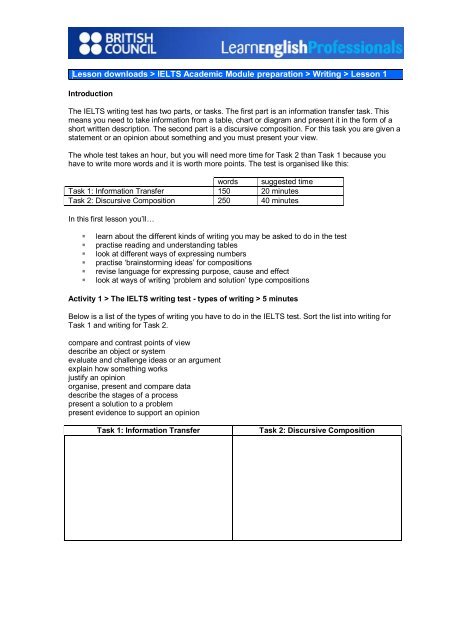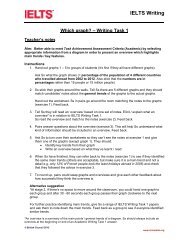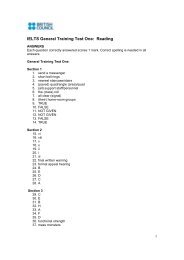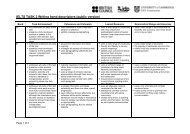Lesson downloads > IELTS Academic Module ... - Take IELTS
Lesson downloads > IELTS Academic Module ... - Take IELTS
Lesson downloads > IELTS Academic Module ... - Take IELTS
- No tags were found...
Create successful ePaper yourself
Turn your PDF publications into a flip-book with our unique Google optimized e-Paper software.
<strong>Lesson</strong> <strong>downloads</strong> > <strong>IELTS</strong> <strong>Academic</strong> <strong>Module</strong> preparation > Writing > <strong>Lesson</strong> 1<br />
Introduction<br />
The <strong>IELTS</strong> writing test has two parts, or tasks. The first part is an information transfer task. This<br />
means you need to take information from a table, chart or diagram and present it in the form of a<br />
short written description. The second part is a discursive composition. For this task you are given a<br />
statement or an opinion about something and you must present your view.<br />
The whole test takes an hour, but you will need more time for Task 2 than Task 1 because you<br />
have to write more words and it is worth more points. The test is organised like this:<br />
words suggested time<br />
Task 1: Information Transfer 150 20 minutes<br />
Task 2: Discursive Composition 250 40 minutes<br />
In this first lesson you’ll…<br />
• learn about the different kinds of writing you may be asked to do in the test<br />
• practise reading and understanding tables<br />
• look at different ways of expressing numbers<br />
• practise ‘brainstorming ideas’ for compositions<br />
• revise language for expressing purpose, cause and effect<br />
• look at ways of writing ‘problem and solution’ type compositions<br />
Activity 1 > The <strong>IELTS</strong> writing test types of writing > 5 minutes<br />
Below is a list of the types of writing you have to do in the <strong>IELTS</strong> test. Sort the list into writing for<br />
Task 1 and writing for Task 2.<br />
compare and contrast points of view<br />
describe an object or system<br />
evaluate and challenge ideas or an argument<br />
explain how something works<br />
justify an opinion<br />
organise, present and compare data<br />
describe the stages of a process<br />
present a solution to a problem<br />
present evidence to support an opinion<br />
Task 1: Information Transfer<br />
Task 2: Discursive Composition
<strong>IELTS</strong> WRITING TASK 1: TABLES<br />
Activity 2 > Understanding Tables > 10 minutes<br />
In <strong>IELTS</strong> Writing Task 1 you may be asked to describe data given in a table. Before you begin<br />
writing, take a few minutes to ‘read’ and understand the table. Think about the following:<br />
• Read the instructions carefully these will tell you what the table shows.<br />
• Does the table have a title? If it does, read it carefully so that you know what the table is<br />
about.<br />
• Is the table static or dynamic? Static tables show data at one point in time; dynamic tables<br />
show how data changes over time. This will affect the language you use in your description.<br />
• What do the columns and rows represent?<br />
• What unit of measurement does each cell represent? Kilometres, euros, litres…??<br />
• Be clear about what the table does not show!<br />
Read this <strong>IELTS</strong> task and then decide whether the statements which follow are true or false or if it is<br />
impossible to tell from the data. Choose T / F or Im<br />
The table below shows how the percentage of British adults who use the Internet changed<br />
over a five year period.<br />
Write a report for a university lecturer describing the information shown below.<br />
Percentage of adults in Great Britain who have used the Internet for 3 months before being<br />
interviewed<br />
Age<br />
groups<br />
October<br />
2000<br />
October<br />
2001<br />
October<br />
2002<br />
October<br />
2003<br />
October<br />
2004<br />
October<br />
2005<br />
1624 70 78 85 88 90 87<br />
2544 53 61 73 76 79 81<br />
4554 46 50 59 64 67 75<br />
5564 24 30 41 45 48 51<br />
Source: National Statistics (see http://www.statistics.gov.uk/copyright.asp for copyright details)<br />
Questions:<br />
1 The table shows the number of people in Great Britain who use the Internet. T / F / Im<br />
2 The table shows the percentage of people in Great Britain who used the Internet between July<br />
and October each year. T / F / Im<br />
3 The table shows change over time (dynamic). T / F / Im<br />
4 In October 2000, more 16 to 24 year olds used the Internet than 25 to 44 year olds. T / F / Im<br />
5 The lowest percentage of Internet use is with the 55 to 64 year olds. T / F / Im<br />
6 In October 2004, only forty eight 55 to 64 year olds used the Internet. T / F / Im<br />
7 10 per cent of 1624 year olds didn’t use the Internet in October 2004. T / F / Im<br />
8 The percentage of people in Great Britain who used the Internet increased over the five years. T /<br />
F / Im
Activity 3 > Ways of expressing numbers > 5 minutes<br />
There are a number of different ways of expressing the same figure in English. For example, we<br />
can say ‘a half’, ‘one in two’ or ‘fifty per cent’ and they all mean the same. It’s a good idea to vary<br />
the way you express figures in your description of the table or chart.<br />
All the phrases below can be used to describe figures. Group them into phrases which mean the<br />
same.<br />
a fifth<br />
a quarter<br />
a tenth<br />
a third<br />
just over sixty per cent<br />
just over thirty per cent<br />
one in five<br />
one in four<br />
one in ten<br />
one in three<br />
seventy five per cent<br />
ten per cent<br />
three out of four<br />
three quarters<br />
twenty five per cent<br />
twenty per cent<br />
two out of three<br />
two thirds<br />
Activity 4: Ways of expressing numbers > 10 minutes.<br />
Now look again at the table about Internet usage from Activity 2. Use expressions from Activity 3 to<br />
complete these sentences about the table. Remember to use a variety of ways to describe the<br />
figures.<br />
1624 year olds had the greatest Internet usage. In 2004, for example, 1 [ ] out of ten people in<br />
this age group used the Internet.<br />
In 2001 just over 2 [<br />
just over 3 [ ].<br />
] of 2544 year olds used the Internet. Two years later, the figure was<br />
For the 4554 age group, Internet usage rose from just under 4 [ ] in 2000 to 5 [ ] in<br />
2005.<br />
In 2000, only one in 6 [ ] 5564 year olds used the Internet. This figure had risen to over 7 [ ] by<br />
2005.
Activity 5: Using quantifiers (1) > 5 minutes<br />
In Part 1 of the writing test you may have to describe amounts. You’ll need to be careful using<br />
quantifiers words like ‘much’, ‘many’, ‘some’ etc.<br />
Put the words and expressions below into the correct group.<br />
a large amount<br />
a little<br />
a lot of<br />
a small amount<br />
a small number<br />
few<br />
fewer<br />
fewer and fewer<br />
less<br />
less and less<br />
many<br />
more<br />
most<br />
much<br />
no<br />
none of<br />
several<br />
the majority of<br />
Used with countable nouns<br />
(men, women, cars, hours etc)<br />
Used with uncountable nouns<br />
(time, money, water etc)<br />
Used with both countable and<br />
uncountable nouns
Activity 6 > Using quantifiers (2) > 10 minutes<br />
The table below show how men and women spend their time each day. It’s a static table i.e. it<br />
doesn’t show changes over time, but compares values at one point in time. Notice also that the<br />
table has two sets of figures: the black figures show time spent in minutes, the blue figures show<br />
the actual number of people asked who said that they do these activities.<br />
Now look at the table and complete the description by choosing the best word or phrase for each<br />
gap.<br />
Time spent by adults (over 16) on daily activities<br />
Men<br />
(total interviewed = 100)<br />
Women<br />
(total interviewed = 100)<br />
Average minutes per day<br />
Activity<br />
(Number of people participating in activity)<br />
Sleep 503<br />
513<br />
100<br />
100<br />
Personal care i.e. 41<br />
52<br />
wash/dress<br />
97<br />
98<br />
Housework 126<br />
215<br />
85<br />
96<br />
Entertainment and 6<br />
6<br />
culture<br />
5<br />
6<br />
Hobbies and games 26<br />
16<br />
26<br />
22<br />
Watching TV 161<br />
137<br />
88<br />
87<br />
Childcare 11<br />
28<br />
14<br />
24<br />
All<br />
508<br />
47<br />
173<br />
6<br />
21<br />
148<br />
20<br />
(adapted from National Statistics information (see http://www.statistics.gov.uk/copyright.asp for<br />
copyright details)<br />
The table shows how 1 [much/many] time people spend on certain daily activities. Not surprisingly,<br />
everybody surveyed spent 2 [a lot of/many] time sleeping. However, men spent slightly 3<br />
[fewer/less] time sleeping than women did. After sleeping, the next most time consuming activity<br />
was housework, taking up 178 minutes per day, on average. Again, though, there was a marked<br />
difference between men and women, with women spending 4 [many/much] more minutes per day<br />
on this activity than men. In addition, a greater 5 [amount/number] of women than men reported<br />
that they spent time on housework and childcare. In contrast, men spent a greater 6<br />
[amount/number] of time on their hobbies and games than women did. Very 7 [few/many] people<br />
surveyed spent much free time on entertainment and culture. For the 8 [majority/most] of people,<br />
free time was spent watching television. Almost nine out of ten people reported that they spent 9<br />
[several/lots] hours watching TV every day.
Activity 7 > Example Task 1 > 10 minutes<br />
Look at the example task 1 question below and then try to complete the sample answer using<br />
language we’ve looked at so far in this lesson.<br />
The table below shows the prevalence of smoking amongst adults in Great Britain. Write a<br />
report for a university lecturer describing the information shown below.<br />
Cigarette smoking status by age and gender<br />
Light<br />
smoker<br />
Heavy<br />
smoker<br />
All<br />
smokers<br />
Men<br />
% of population<br />
1619 19 4 23<br />
2024 32 5 36<br />
2534 26 9 35<br />
3549 18 12 31<br />
5059 13 12 26<br />
60 and over 10 5 15<br />
Women<br />
1619 24 1 25<br />
2024 25 5 29<br />
2534 22 6 28<br />
3549 19 9 28<br />
5059 14 8 22<br />
60 and over 10 4 14<br />
The table shows [<br />
] and compares the<br />
prevalence of smoking [<br />
]. It’s clear from the figures that smoking is<br />
most common [ ]. Nearly [ ] men and exactly<br />
[ ] women are light smokers at this age, while<br />
[ ] are heavy smokers. The figures also show that as age increases<br />
[ ]. This trend is true for [ ] . The most<br />
disturbing figures are those for 16 to 19 year olds. Around [<br />
] . The<br />
percentage for girls [<br />
] in this age group, but it seems that teenage boys<br />
[ ].
<strong>IELTS</strong> WRITING TASK 2: PROBLEM AND SOLUTION<br />
Activity 8 > Brainstorming ideas (1): 5 minutes<br />
In Part 2 of the <strong>IELTS</strong> test you may be asked to write a composition discussing the causes of a<br />
problem and suggesting possible solutions. Here’s an example:<br />
Present a written argument or case to an educated reader with no special knowledge of the<br />
following topic.<br />
Overfishing of the world’s oceans threatens many species with extinction and is putting<br />
the livelihood of millions of people around the world at risk. What are the causes of this<br />
problem and what can be done to prevent it from happening?<br />
You should use your own ideas, knowledge and experience and support your arguments with<br />
examples and relevant evidence.<br />
Before you begin writing, spend a few minutes to think of ideas related to the topic. At this stage,<br />
don’t worry too much about how you’re going to express or organise these ideas just ‘brainstorm’<br />
the topic and jot down notes.<br />
Spend 3 minutes brainstorming ideas for the example question above. Use these headings:<br />
Causes of overfishing<br />
Ways to prevent overfishing<br />
Activity 9 > brainstorming ideas (2) > 5 minutes<br />
Here are some ideas we’ve ‘brainstormed’ for the composition. Put each idea under the appropriate<br />
heading.<br />
‘factory fishing’ makes huge catches too easy<br />
bring in laws to protect fish species and limit fishing<br />
create an international body to police the oceans and enforce laws<br />
fishing provides a quick return for companies and governments<br />
huge areas of the world’s oceans are not protected by environmental laws<br />
illegal fishing is difficult to police<br />
put taxes on fishing which make it less attractive to companies<br />
raise public awareness though the media<br />
the problem does not get enough publicity<br />
there’s a growing demand for fish worldwide<br />
ban the fishing of certain species of fish<br />
Causes of overfishing<br />
Ways to prevent overfishing
Activity 10 > Expressing cause and effect (1) > 10 minutes<br />
If you are asked to discuss a problem and possible solutions in Task 2, you will need to be able to<br />
outline the causes of the problem and show what effects these have. Here are some useful<br />
expressions for doing this.<br />
RESULT<br />
(is)<br />
due to<br />
owing to<br />
because of<br />
caused by<br />
brought about by<br />
on account of<br />
as a result of<br />
CAUSE<br />
CAUSE<br />
results in<br />
causes<br />
gives rise to<br />
leads to<br />
brings about<br />
accounts for<br />
RESULT<br />
Each of the sentences below describes a cause and effect relationship. Choose the best expression<br />
to complete the gap.<br />
1 Global warming is partly [as a result of/causes] increasing emissions of greenhouse gases.<br />
2 The decline of manufacturing industry [on account of/brought about] high unemployment in<br />
many countries.<br />
3 People are more worried about crime [on account of/brings about] exaggerated reports in the<br />
media.<br />
4 Increasing pressure to work overtime [owing to/causes] parents to spend less time with their<br />
children.<br />
5 Drugs for the treatment of AIDS remain unavailable to millions [owing to/gives rise to] their high<br />
cost.<br />
6 Globalisation [as a result of/has given rise to] a bland ‘pop culture’ followed by young people<br />
worldwide.<br />
7 Poor discipline at school [is due to/leads to] poor parenting at home.<br />
8 The desire for higher profits [on account of/leads to] companies setting up in countries where<br />
labour is cheap.
Activity 11 > Expressing cause and effect (2) >5 minutes.<br />
Now let’s see how these expressions can be used in our composition about the overfishing of the<br />
world’s oceans. Complete the paragraph by using appropriate phrases from activity 9.<br />
There are a number of reasons why overfishing of the world’s fish stocks has reached crisis levels.<br />
Firstly, catching large numbers of fish has become very easy [1 ] modern methods of factory<br />
fishing. Secondly, the scarcity of fish [2 ] higher prices, making fishing a more attractive<br />
industry for governments and companies to invest in. This [3 ] even more fishing and<br />
[4 ] a vicious circle of increasing demand and diminishing supply. Furthermore, fishing in<br />
most parts of the world remains uncontrolled [5 ] the lack of environmental laws. Finally,<br />
where laws do exist they are difficult to enforce [6<br />
] the lack of an international<br />
maritime police authority.<br />
Activity 12 > Suggesting solutions > 10 minutes<br />
Once you have discussed the causes of the problem, you are ready to put forward your suggestions<br />
for possible solutions. For every suggestion you make, you need to back up your argument by<br />
explaining how this idea will help. Again, there are useful words and phrases for you to do this.<br />
The phrases below are used to show the purpose or reason for doing something. Match each one<br />
with the verb form which follows it.<br />
1<br />
so (that)<br />
in this way<br />
A<br />
to prevent overfishing<br />
2 with the purpose of B overfishing is prevented<br />
3<br />
in order<br />
so as<br />
C<br />
preventing overfishing<br />
Now complete this paragraph with phrases from above.<br />
What can be done in [1 ] prevent fish species being wiped out by overfishing? One immediate<br />
measure is to put a complete ban on the fishing of certain species of fish [2 ] save them from<br />
extinction. Environmental agencies should work to give the problem a higher profile in the media<br />
[3 ] the public become more aware. Governments can help by imposing taxes on the fishing<br />
industry. [4 ], companies may be less likely to see fishing as an easy way to make money.<br />
Governments should also bring in stricter laws in order to protect fish stocks from uncontrolled<br />
factory fishing. Finally, an international body ought to be created [5 ] enforcing these laws<br />
worldwide.
Activity 13 > Example Task 2<br />
Here’s another example of a task 2 question requiring a ‘problem and solution’ approach. Spend<br />
five minutes brainstorming the question, and then write your composition, using language we have<br />
looked at during this lesson.<br />
Present a written argument or case to an educated reader with no special knowledge of the<br />
following topic.<br />
The numbers of indigenous peoples living traditional lives in the world’s rainforests are<br />
becoming fewer and fewer. Within a few decades the last of these indigenous tribes may<br />
have disappeared forever. What are the causes of this problem and what can be done to<br />
prevent it from happening?<br />
You should use your own ideas, knowledge and experience and support your arguments with<br />
examples and relevant evidence.<br />
<strong>Lesson</strong> Review<br />
In this em@il lesson you have:<br />
• learnt about the different kinds of writing you may be asked to do in the test<br />
• practised reading and understanding tables<br />
• looked at different ways of expressing numbers<br />
• practised ‘brainstorming ideas’ for compositions<br />
• revised language for expressing purpose, cause and effect<br />
• looked at ways of writing ‘problem and solution’ type compositions







